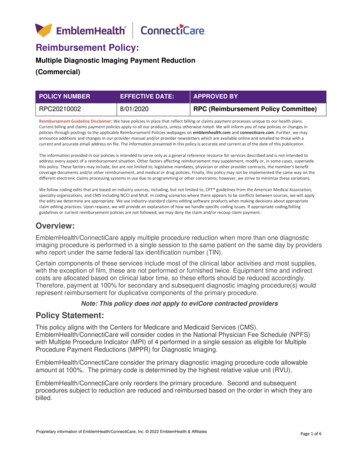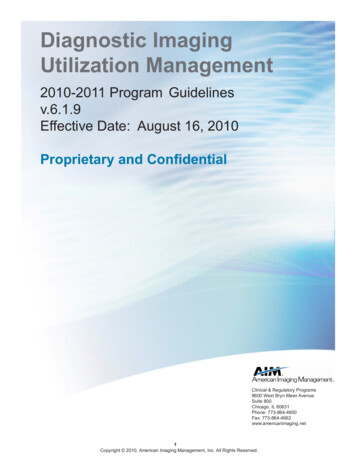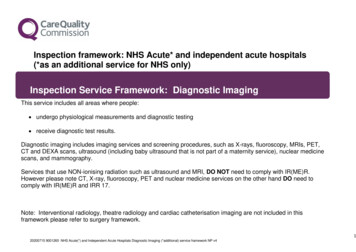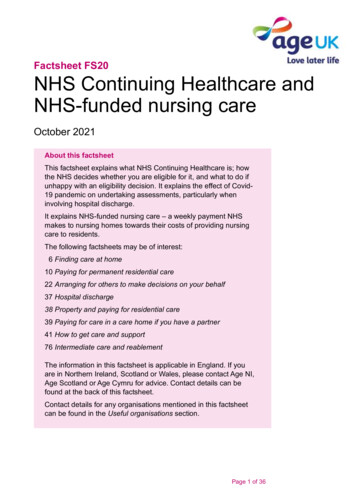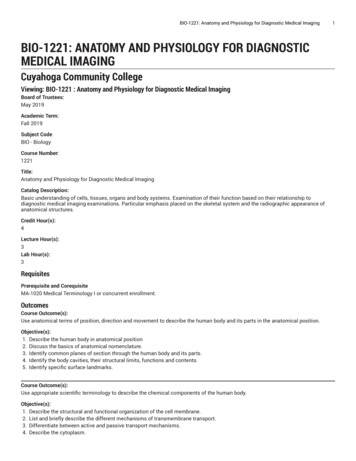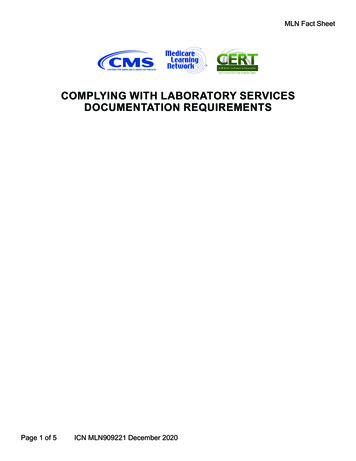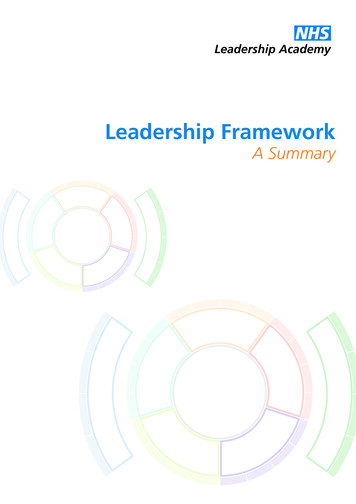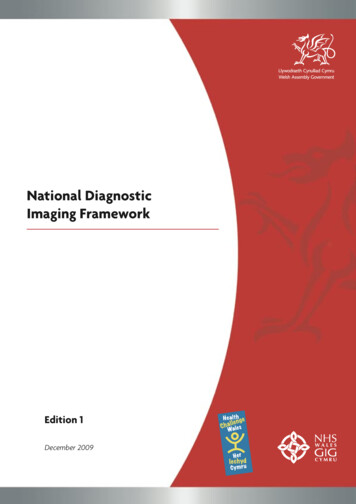
Transcription
National DiagnosticImaging FrameworkEdition 1December 2009
Crown copyright 2009E4760910
ContentsPageExecutive Summary11.Introduction31.1 The Future Delivery of Diagnostic Imaging Services in Wales31.2 Diagnostic Imaging Services covered by this Framework4Guidance and Standards which impact on Diagnostic Imaging42.1 Waiting Times42.2 Healthcare Standards for Wales42.2.3 National Service Frameworks (NSFs)2.3.1 NSF for Children, Young People and Maternity Servicesin Wales152.3.2 The Cardiac Disease National Service Framework162.3.3 Diabetes NSF252.3.4 Adult Mental Health NSF252.3.5 National Service Framework for Older People262.3.6 Renal NSF272.4 Other Relevant Standards and Guidance3.15292.4.1 Delivering Emergency Care Services (DECS)292.4.2 Designed to Improve Health and the Management ofChronic Conditions in Wales292.4.3 Quality Requirements for Adult Critical Care in Wales302.4.4 Stroke Guidelines312.4.5 The Cancer Standards332.4.6 National Institute for Health and Clinical Excellence(NICE) Guidance36Quality and Standards in Diagnostic Imaging363.1 Accreditation363.2 Interventional Radiology373.3 Information Management and Technology (IM&T)393.4 Benchmarking39
3.5 Radiation Protection Legislation4.403.5.1 IR(ME)R 2000403.5.2 Healthcare Inspectorate Wales Self Assessment Tool403.5.3 IRR99403.6 National Patient Safety Agency (NPSA) Advice413.7 Recommended Standards for the Routine Performance Testing ofDiagnostic X-Ray Imaging Systems413.8 Standard Protocols and Methods423.9 Other Quality Related Documents42Appropriate Use of Imaging434.1 Royal College of Radiologist Guidelines (RCR)434.2 Non Medical Referral for Diagnostic Imaging434.3 Reporting of Imaging Investigations44Appendix 145References49
Executive SummaryThe National Diagnostic Imaging Framework (NDIF) for Wales provides an overviewof the standards applicable to the planning and delivery of diagnostic imagingservices in Wales at local, regional or national levels as appropriate. It should beread in relation to the recommendations set out in ‘The Future Delivery of DiagnosticImaging Services in Wales’.Evidence of compliance with the standards herein will help organisations meet therequirements of the Healthcare Standards for Wales, and the requirements of theWelsh Assembly Government (WAG) for key patient groups as specified in theNational Service Frameworks (NSFs) and other strategic documents.The National Diagnostic Imaging Framework: provides assurance to patients that the services they receive are of thehighest quality; identifies the Healthcare Standards that impact on diagnostic imaging andclarifies the quality standards to which diagnostic imaging services areexpected to perform; and provides the context to enable planners to identify areas where resourcesmay be required to meet standards.Section 1 puts the NDIF into context and contains details of the diagnostic imagingservices covered by this Framework.Section 2 sets out quality standards which diagnostic services should meet to fulfilthe requirements of the Healthcare Standards for Wales and the NSFs.Section 3 sets out additional requirements specific to the provision of high qualityservices within imaging departments.Section 4 describes standards for the appropriate use of imaging.1
2
1.IntroductionThe National Diagnostic Imaging Framework (NDIF) references a wide range ofstandards and guidance that diagnostic imaging service providers will be expected todemonstrate compliance with.The NDIF provides a mechanism for assessing current and future services includingthose that require investment of either capital or revenue. Service developments thatare in line with this framework should be encouraged. Priorities for service delivery indifferent healthcare environments are described, but it does not define theorganisational structures within which services will be delivered. The Frameworkspecifically identifies the contribution of diagnostic imaging to broader policies andguidelines such as the Healthcare and Cancer Standards and National ServiceFrameworks (NSFs).The contents of this document have been agreed with service providers andplanners, and endorsed by the Medical Imaging Sub Committee of the WelshScientific Advisory Committee. The standards are evidence based, measurable andaligned with broader service development.The purpose of this document is to: provide assurance to patients that the services they receive are of thehighest quality; identify the Healthcare Standards that impact on diagnostic imaging andclarify the quality standards to which diagnostic imaging services areexpected to perform; and provide the context to enable planners to identify areas where resourcesmay be required to meet standards.Individuals working within imaging services must adhere to their registration bodyand employer Codes of Conduct and professional standards where appropriate. TheRoyal College of Radiologists (RCR), the Society and College of Radiographers(SCoR), the Royal College of Nursing (RCN), the Institute of Physics andEngineering in Medicine (IPEM) and the Health Professions Council (HPC) provideprofessional advice and guidance which is updated on a regular basis. These bodieshave produced a range of standards which are available on their websites.Imaging related quality requirementEvidenceRegistration with appropriate regulatorybody where applicable.Registration checked on an annualbasis.1.1The Future Delivery of Diagnostic Imaging Services in Wales(1)The Future Delivery of Diagnostic Imaging Services proposes a way forward for theplanning and delivery of diagnostic imaging services in Wales, and builds on thecollaborations that are already underway in order to deliver the range and quality ofservice required by a changing health service.3
1.2Diagnostic Imaging Services covered by this FrameworkThe consensus from stakeholders in the imaging community is that the samestandard of service provision should apply to all imaging services regardless oflocation.Therefore, the Framework will apply to radiology departments; Breast Test Wales;nuclear medicine departments; medical physics departments; point of care settingssuch as ultrasound undertaken in Outpatient or GP clinics; and other departmentswhere a range of imaging modalities are undertaken. Specific quality requirementsfor these services will be available in updated versions of the document as theybecome available. The modalities covered by this Framework are shown inAppendix 1.2. Guidance and Standards which impact on DiagnosticImaging2.1Waiting TimesAccess 2009 Targets(2) require that the patient care pathway from initial contact withprimary care to diagnosis and treatment must be completed within 26 weeks with amaximum 8 weeks waiting time for access to specified diagnostic services.Imaging related quality requirementEvidenceMaximum 8 weeks waiting time foraccess to specified diagnostic services.Audit of waiting times.2.2Healthcare Standards for WalesThe Healthcare Standards for Wales(3) came into effect from June 2005 andconstitute a common framework of healthcare standards to support the NHS andpartner organisations in providing safe, high quality care for all patients in Wales.Along with the development of National Service Frameworks and National Institutefor Clinical Excellence (NICE) guidance, this forms part of a sustained drive toremove inequalities in health across the breadth of Wales.The standards are grouped into four domains: The Patient Experience – The standards support the provision ofhealthcare in partnership with patients, service users, their carers andrelatives and the public; Clinical Outcomes – Healthcare decisions and services should be basedon appropriately assessed research evidence of an effective outcome forpatients and service users; Healthcare Governance – Providers and commi
Diagnostic X-Ray Imaging Systems 41 3.8 Standard Protocols and Methods 42 3.9 Other Quality Related Documents 42 4. Appropriate Use of Imaging 43 4.1 Royal College of Radiologist Guidelines (RCR) 43 4.2 Non Medical Referral for Diagnostic Imaging 43 4.3 Reporting of Imaging Investigations 44 Appendix 1 45 References 49
